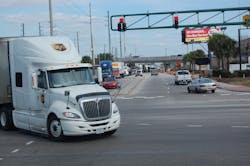Major transformation ahead for freight transportation, say analysts
The freight transportation industry – particularly trucking – is undergoing and will continue to undergo what analysts describe as “major” transformation in the near-term due to a variety of intersecting factors involving everything from increased regulatory oversight to demands for more “paperless” transmission of shipment information.
“The airline industry has gone through it, the consumer industry has gone through it, and the freight industry is next,” John Donahue, newly-installed director of PricewaterhouseCooper’s (PwC’s) transportation and logistics practice, told Fleet Owner.
“Most trucking carriers still rely on paper invoicing for example but there are huge savings from moving to electronic invoicing,” Donahue noted. “There are also a tremendous number of ‘legacy’ computer systems out there that are being retired or close to it, so a new wave of technology is about to develop within the industry.”
He added that the need for electronically-based freight shipment data is important not just in terms of meet customer demands but to help address regulatory compliance and asset management needs. “Leveraging data is how carriers will increase revenues with existing assets,” Donahue pointed out.
Wall Street investment firm Stifel Nicolaus & Co. also identified several “game changers” in a report issued earlier this month looking at major trends predicted to affect the U.S. transportation and logistics market in 2014, with data management playing a key role in how trucking companies deal with potentially slower freight growth due to supply-chain optimization efforts.
“Adding to slow economic growth is a laser focus on the part of shippers and carriers to drive down the size and weight of products, enhance product packaging efficiency, reduce empty miles, maximize equipment utilization, select transportation modes, and select the best carriers for each lane,” Stifel noted.
“Carriers/logistics companies offering transportation management systems, a supply chain solutions mentality, and a willingness to continually optimize a shipper's supply chain should be poised to win more business, especially if they can contribute some assets to the optimized solutions designed for shippers,” the firm said.
PwC’s Donahue added that such “optimization” is being felt strongly where trucking and intermodal intersect. “This is an area of freight transportation that’s going through a lot of transformation and [intermodal] chassis management will be a huge piece of the information demand going forward,” he noted.
Stifel also projects that information needs will be further inflamed by the “regulatory onslaught” faced by trucking as well as other modes in 2014.
“In an effort to make the trucking and railroad industries safer, reduce harmful emissions, and improve fuel economy, the states and the federal government are promulgating a cavalcade of rules, regulations and laws that in their totality amount to a significant burden for asset-based freight transportation companies,” the firm said.
Smaller trucking companies, in particular, will find the requirements so overwhelmingly onerous that their economic viability will be impaired, Stifel emphasized, with others forced to downsize.
“In contrast, the larger, more sophisticated carriers are best positioned to interpret and react to the complicated, sometimes conflicting, always expensive swirling myriad of edicts from ‘on high,’” Stifel said. “With less overall capacity surviving this well-intentioned government overreach, the larger more sophisticated carriers will prosper as they will be able to effectively and efficiently allocate their compliant capacity to the highest bidding and most operationally cooperative shippers.”
The firm further stressed that as small carriers must also become compliant with a seemingly ever-longer list of rules and regulations, their inherent “dis-economies of small scale” will rise to the surface.
“Large carriers with equipment purchasing and disposition advantages, other purchasing advantages [for] fuel, tires, parts, etc., [as well as] network density economies, multiple service offerings, and optimization systems will increasingly distance themselves from their smaller competitors,” Stifel explained. “Those carriers with the ability to continuously optimize customers' supply chains while bringing an ever changing mix of their own and other carriers’ assets to bear may successfully distance themselves from the competition.”
About the Author
Sean Kilcarr
Editor in Chief
Sean Kilcarr is a former longtime FleetOwner senior editor who wrote for the publication from 2000 to 2018. He served as editor-in-chief from 2017 to 2018.
